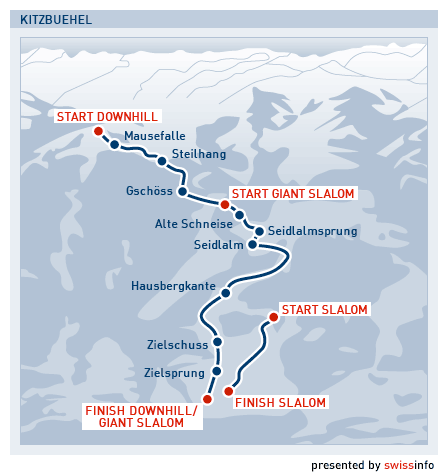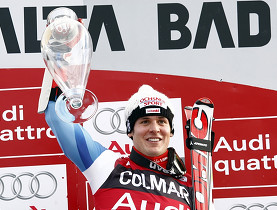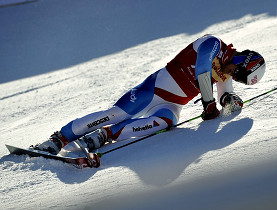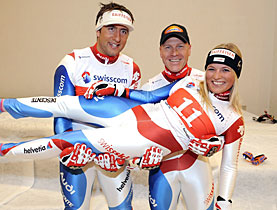Ski race injuries prompt serious questions

The line between winning a downhill ski race and suffering a serious injury instead is often razor thin. One Swiss Ski team doctor wants to know where it lies.
In the past 15 months, four downhill skiers have been badly hurt, the latest being Daniel Albrecht. The Swiss skier crashed in Kitzbühel on Thursday and remains in an induced coma with brain and lung injuries.
Hans Spring, head doctor for the Swiss men’s ski team, says ski racing has become much safer than it was in the earliest days of World Cup races in the 1960s, when veering off course could mean slamming into a tree.
With better safety nets, crash pads and well marked courses, race organisers have used accidents to create better safety measures.
But more could be done, Spring says.
He has taken a closer look at the last four serious downhill crashes to see what can be learned and what new safety measures they might prompt.
Human error
The crashes Spring looked at started in November 2007 when Norwegian skier Aksel Lund Svindal crashed on a training run in Beaver Creek, Colorado. The then-27-year-old athlete fractured facial bones, chipped a tooth and sliced his buttocks and groin deeply with his own skis.
In March 2008, Matthias Lanzinger’s life was drastically altered when the Austrian skier broke his leg so badly it had to be amputated.
American skier Scott Macartney crashed in the same spot as Albrecht did but a year earlier. He too had to be airlifted out and placed in an artificial coma. Macartney recovered and was racing again this year before a knee injury at a World Cup race in Wengen cut his season short.
“It might sound brutal but each time it’s been skier error,” Spring told swissinfo. “Albrecht didn’t hit the jump right.”
He hit the jump at a blistering 130km/h and air was able to get under his skis, tossing him onto his back. The sudden increase in wind resistance slowed him down dramatically and he plummeted onto the icy surface from five metres up. His bindings ripped out and he snapped his skis. He lay there unconscious.
“At these speeds an error can have a big impact,” Spring said, adding that the truly astonishing part is that Albrecht did not suffer a worse fate than he did considering the forces that ripped through his body.
50-50 chance
While no hard statistics exist on serious downhill skiing injuries, Urs Lehmann, president of Swiss Ski, told a radio interviewer in Switzerland this week that skiing racing’s governing group, the International Ski Federation (FIS), has to do more to keep athletes safe.
“We are at the point where some fundamental thinking needs to be done,” he said. “It can’t be that an athlete at the start of a season has a 50-50 chance of making it to spring without injury.”
For one thing, Spring says courses should not have a final crowd-pleasing jump right before the finish. Racers are mentally and physically exhausted by that point, and hurling them for 50 metres through the air is much too dangerous.
Others like Martin Rufener, the team’s head trainer, have suggested that more training for downhillers might help but even then accidents will still happen.
“It was a mistake,” he told a ski reporter after Albrecht’s wreck. “It can happen. Preparing for the jump, it wouldn’t have made a difference.
“You can’t say it would not have happened. Everyone knows that downhill racing is dangerous.”
swissinfo
The Streif course down the Hahnenkamm mountain in Kitzbühel, Austria, is particularly vicious for downhill ski racers because of its numerous tricky sections and long length, which punish even the most well trained skiers.
The course drops 862 vertical metres over 3.3 kilometres. The steepest sections tip back to more than 40 degrees.
As with other downhill courses, workers inject water into the surface of the Streif to freeze it into a sheet of ice. Skiers can reach such high speeds on the course – upwards of 160km/h – that the friction will sometimes burn the bottoms of their skis.
So many skiers have crashed on the course, often horrifically, that some top athletes will skip the World Cup event altogether, forfeiting the points in exchange for better odds of making it to spring injury free.
The record course time was set in 1997 by Fritz Stobl of Austria who completed the course in 1:51:58, with an average speed of 106.9km/h.
Austrians have won the race 21 times in 41 years. After that comes Switzerland, with 12 wins, including 2008 when Didier Cuche took the gold with 1:52:75. He also won it in 1998. Swiss skier Franz Heinzer has won the race three times.


In compliance with the JTI standards
More: SWI swissinfo.ch certified by the Journalism Trust Initiative











You can find an overview of ongoing debates with our journalists here . Please join us!
If you want to start a conversation about a topic raised in this article or want to report factual errors, email us at english@swissinfo.ch.